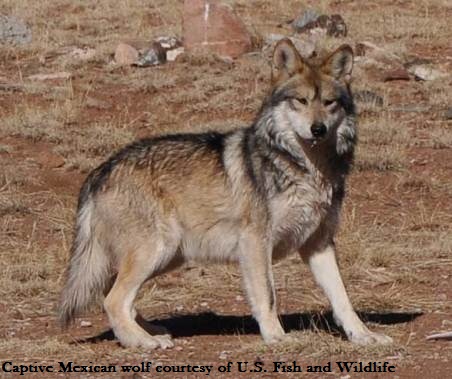A history of wolves in Texas: From native top predators to a fading memory
By Steve West, Staff Scientist and Texas Director New Mexico Wilderness Alliance
Texas is wolf country
At one time, there were two species of wolves in Texas: the southeastern red wolf (Canis rufus) and the once more widespread gray wolf (Canis lupus). The favorite among southwest conservationists is a subspecies of the gray wolf called the Mexican gray wolf (Canis lupus baileyi).
Mexican wolves once roamed across west Texas, New Mexico, Arizona and northern Mexico. After a century of persecution, poisonings, trapping and a great deal of ignorance, the last wolves were recorded in Arizona, New Mexico and in Texas in 1970. All three of these remaining Mexican lobos were killed.
The demise of Mexican wolves in Texas was complete by 1970. In that year, two were killed in December at separate locations in Brewster County where Big Bend National Park is located. Under natural conditions, wolves fed on a large variety of animals, with deer making up a large percentage of the total. Opportunistically, they will feed on just about anything, including rabbits, squirrels, birds and reptiles. When natural game is scarce, wolves may take livestock, but in a functioning, healthy ecosystem this is the exception, not the rule.
Texas was wolf country and the wolf is as much a part of Texas natural history as the armadillo. But while armadillos are thriving, the future of the Mexican wolf in Texas is not secure. In the late 90s, Mexican wolves were released into the Greater Gila Area into Arizona and eventually New Mexico. These wolves have struggled to survive for a variety of reasons–most of them because of conflict or perceived conflict between humans and wolves.
Why we need wolves in Big Bend National Park
Releasing wolves in Texas will not be an easier sell than it was in New Mexico and Arizona. Still, there are many reasons why wolves should be released in Texas, and especially in Big Bend country. The first reason is that wolves belong in the Lone Star State. They are part of the natural heritage of Texas, and should be returned to their rightful place.
The goal is also achievable and beneficial. Big Bend National Park, at more than 800,000 acres, provides good habitat for wolves. Having them in the park would address out-of-balance populations of mule deer, javelina and feral donkeys. Additionally, they would help stem feral hogs that have recently appeared in the northern part of the park.
Having wolves in Big Bend National Park would enhance the experience of visitors, whether or not they see wolves. Knowing they are there would add to the visit, and hearing them would be a terrific memory! Another reason to reintroduce wolves in the park would be that, with time, another secure, self-supporting population could be established. If enough of these sites can be created, the status of this highly endangered animal could be moved away from the abyss of extinction.
Lobello and Miss Sully’s injustice
Public outcry for establishing populations of Mexican wolves in the American southwest actually began in Texas. In the 70s, Rick Lobello, an employee at Big Bend, began gathering support for the release of the species in the park. That has yet to happen, but a debt is owed to Rick for starting the process. Now is the time to do this.
The injustice of removing wolves with the desire of making this permanent has been a tragedy on many levels. That last wolf wandering across Brewster County had to wonder what was happening. “Where have all the others gone?” it must have wondered. Yet that was not the last wolf to die in Texas. Sul Ross State University (SRSU) in Alpine, Texas, picked the wolf (also known as the lobo) as their mascot as early as 1924 when there still had to be a number of wolves wandering across the borderlands. The first lobo mascot was given to the university in 1925. It was kept in captivity and appeared at games. History does not record what happened to this individual.
The second and last lobo mascot arrived at SRSU in 1966. Reports say this wolf arrived from Tucson and was given the name Sully. They later discovered that the wolf was a female and was thereafter referred to as Miss Sully. I remember seeing Miss Sully in a small cage on the main drive through the campus. The cage had virtually no shelter, and was small and confined. In my eyes, this was a terrible way to treat any animal. Miss Sully died in 1974. Some coward decided they didn’t even like this one captive wolf in Texas and they threw poisoned meat into her cage. No doubt Miss Sully died a horrible death and the killer was never brought to justice. She deserved better, as did the thousands of wolves in west Texas that went before her.
On August 25, 1916, President Woodrow Wilson signed The Organic Act, which established the National Park Service. Part of the act states, “The Service thus established shall promote . . . measures as to conform to the fundamental purpose . . . (which) is to conserve the scenery and natural and historic objects and the wildlife therein . . .” Having wolves back in the Big Bend National Park is the right thing to do, and is an obligation of the Organic Act, if the act is to mean anything. For the park ecosystem, for the enjoyment of visitors and most of all, for the wolves themselves, this has to happen. Not least of all to get a small measure of justice for Miss Sully and Mr. Lobello.
This article came from Our Wild Texas, a project of the New Mexico Wilderness Alliance.
*****************************************************************************************************************************************
Click here to join our email list for news, action items, and updates.
Photo of captive Mexican gray wolf M968 at Sevilleta courtesy of the U.S. Fish and Wildlife Service



